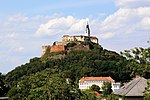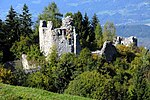Forchtenstein Castle
the public
Forchtenstein Castle (German: Burg Forchtenstein; Hungarian: Fraknó vára; Croatian: Fortnavski grad) is a castle built in the Late Middle Ages near the municipality of Forchtenstein in northern Burgenland, Austria. Forchtenstein Castle is 511 metres (1,677 ft) above sea level.[1]
Location
The castle is south of Mattersburg above the Wulka valley.
History
The first part of the castle with its 50-metre (160 ft) high keep was built in the beginning of the 15th century by the Lords of Mattersburg, who later named themselves Lords of Forchtenstein.
The castle features a tower, known as the 'Black Tower' although the black rock that originally lined the tower has since been stripped. The tower contains a 12-metre (40 ft) deep pit used as a prison cell for those condemned to death. Rezallia, wife of Lettus of Forchtenstein used this with great frequency; on the return of her husband from military service, she was herself sentenced to death in the tower by her husband.
Around 1450 the Lords of Forchtenstein died off due to lack of a male heir and the castle was passed over to the House of Habsburg, which owned it for 170 years. They leased it to others, including the Counts of Weissbriach and Hardegg. During this time the building was not changed significantly.
In 1622 Nikolaus Esterházy, founder of the western Hungarian Esterházy line, received the castle from Emperor Ferdinand II, and Esterházy became a Count. Nikolaus started to fortify the crumbling castle and refurbished it with the services of Vienna builder Simon Retacco from 1630 to 1634 and with Domenico Carlone from 1643. The construction workers were all from Italy. This led to big orders for three masters of Kaisersteinbruch, the imperial quarry: Ambrosius Petruzzy, Pietro Maino Maderno, and Mathias Lorentisch. Kaiserstein stone was used for the main portals, fountains, cannonballs, etc. Once hewn the stone was delivered on large wagons drawn by six oxen.
In the second half of the 17th century his son Paul further extended and ornamented the castle with architect Domenico Carlone. After Paul's death the castle's function changed. It became a repository for weapons, archives, chronometers, machines, exotic animal preparations and other "marvels". The only access to the treasure vault was a secret passage leading to a door requiring two different keys used together. One key was kept by the Count and the other by his treasurer. In the second half of the 18th century the castle was extended by master builder Ferdinand Mödlhammer. During this work the roof truss was lifted and the interior was renovated.
The treasure vault remained undiscovered and intact throughout World War II. The original glass-paned cabinets containing the collection are works of art in themselves.
The castle is still owned by the Esterházy family and, together with Schloss Esterházy in Eisenstadt, it chronicles the history and treasures of this ancient aristocratic family.
When Austria and Hungary separated in 1921, the Esterházy family's lands were split between the two countries. Their financial records remained at Castle Forchtenstein and the family records were taken to the Hungarian Federal Archive in Budapest.
Gallery
- West view
-
 Aerial view
Aerial view -
 Courtyard with frescoes
Courtyard with frescoes -
 Treasure and marvel chamber
Treasure and marvel chamber - Fountain, hard Kaiserstein
See also
References
- ^ Forchtenstein Castle Altitude and Location
External links
- Burg Forchtenstein Archived 2018-08-15 at the Wayback Machine - Official homepage
- Photo gallery Castle Forchtenstein Archived 2013-12-02 at the Wayback Machine
- Air views of the castle
- v
- t
- e
- Burg Bernstein
- Burg Forchtenstein
- Burg Güssing
- Burgruine Landsee
- Burg Lockenhaus
- Burg Schlaining







- Burgruine Aichelburg
- Klosterruine Arnoldstein
- Burgruine Dietrichstein
- Burgruine Falkenstein (Oberfalkenstein)
- Burg Falkenstein (Niederfalkenstein)
- Burgruine Feldsberg
- Burgruine Federaun
- Burgruine Finkenstein
- Burgruine Flaschberg
- Burg Freiberg
- Burg Geyersberg
- Burgruine Glanegg
- Burgruine Gmünd
- Burgruine Goldenstein
- Burgruine Gomarn
- Burgruine Gradenegg
- Burgruine Grafenstein
- Burgruine Greifenfels
- Burgruine Griffen
- Burgruine Groppenstein
- Burgruine Grünburg
- Burgruine Gurnitz
- Burg Haimburg
- Burgruine Hardegg
- Burgruine Hartneidstein
- Burgruine Himmelberg
- Burg Hochosterwitz
- Burgruine Hohenburg
- Burgruine Hohenburg auf Rosenberg
- Burgruine Hohenwart
- Schloss Hollenburg
- Burgruine Karlsberg
- Burgruine Kühnburg
- Burgruine Landskron
- Burgruine Lavant
- Burgruine Leobenegg
- Burgruine Leonstein
- Burgruine Lichtengraben/Painburg
- Burgruine Liemberg
- Burgruine Liebenfels
- Burg Mannsberg
- Burgruine Moosburg/Arnulfsfeste
- Burg Neudenstein
- Burgruine Nussberg
- Burgruine Ortenburg
- Burgruine Petersberg
- Burgruine Prägrad
- Burgruine Rabenstein
- Burgruine Ras
- Burgruine Rauchenkatsch
- Burgruine Rauterburg
- Burgruine Rechberg
- Burgruine Reifnitz
- Burgruine Reinegg
- Burgruine Reisberg
- Burgruine Rosegg
- Burgruine Rothenthurn
- Burgruine Rottenstein
- Burgruine Schaumburg
- Burgruine Silberberg
- Burg Sommeregg
- Burgruine Sonegg
- Burgruine Sternberg
- Burgruine Steuerberg
- Burg Straßburg
- Burgruine Straßfried
- Burgruine Taggenbrunn
- Burgruine Treffen
- Burgruine Twimberg
- Burgruine Waisenberg
- Burgruine Weidenburg
- Burgruine Weißenegg
- Burgruine Wullroß
- Burgruine Aggstein
- Burgruine Araburg
- Burgruine Dobra
- Burgruine Dürnstein
- Castle Falkenstein (Lower Austria)
- Franzensburg
- Burg Greifenstein
- Burg Grub
- Burg Hardegg
- Burg Hartenstein
- Burg Heidenreichstein
- Burgruine Kaja
- Burg Karlstein
- Burgruine Kollmitz
- Burg Kreuzenstein
- Burg Liechtenstein
- Burgruine Mödling
- Burg Neulengbach
- Burg Ottenstein
- Burg Perchtoldsdorf
- Burg Plankenstein
- Burg Persenbeug
- Burg Raabs an der Thaya
- Burg Rappottenstein
- Burgruine Rauheneck (Baden)
- Burgruine Rauhenstein
- Rosenburg
- Schallaburg
- Burg Scharfeneck
- Burg Seebenstein
- Burgruine Senftenberg
- Burgruine Starhemberg
- Schloss Walpersdorf
- Burg Wiener Neustadt
- Burg Alt-Teuffenbach
- Burg Baiersdorf
- Burg Deutschlandsberg
- Burg Dürnstein
- Schloss Eggenberg (Graz)
- Burg Ehrenfels (St. Radegund)
- Schloss Ehrenhausen
- Burgruine Eppenstein
- Schloss Feistritz / Ilz
- Burg Festenburg
- Burgruine Fohnsdorf
- Burg Forchtenstein
- Frauenburg (castle)
- Schloss Frondsberg
- Burgruine Gallenstein
- Schloss Gleichenberg
- Schloss Grosssölk
- Burg Grünfels
- Schloss Gutenberg
- Ruine Hauenstein
- Ruine Henneberg
- Schloss Herberstein
- Ruine Hohenwang
- Burg Kammerstein/ Ehrenfels
- Ruine Kalsberg
- Burg Kaisersberg
- Ruine Katsch
- Ruine Klingenstein /Salla
- Ruine Klöch
- Burg Krems
- Ruine Ligist
- Burg Neuberg
- Burg Neuhaus bei Stubenberg
- Ruine Neu-Leonroth
- Burg Lichtenegg
- Ruine Liechtenstein
- Ruine Neudeck
- Burg Oberkapfenberg
- Burg Obervoitsberg
- Ruine Offenburg
- Ruine Pernegg
- Ruine Pflindsberg
- Burgruine Pfannberg
- Burgruine Pikeroi
- Ruine Puxer-Loch
- Ruine Raabeck
- Schloss Rabenstein
- Burgruine Reifenstein
- Riegersburg Castle
- Burg Schachenstein
- Ruine Schmirnberg
- Schloss Seggau
- Burgruine Steinschloß
- Burgruine Sturmberg
- Burg Thalberg
- Burg Waldstein
- Burgruine Waxenegg
- Burgruine Wildon
- Burgruine Wolkenstein

















